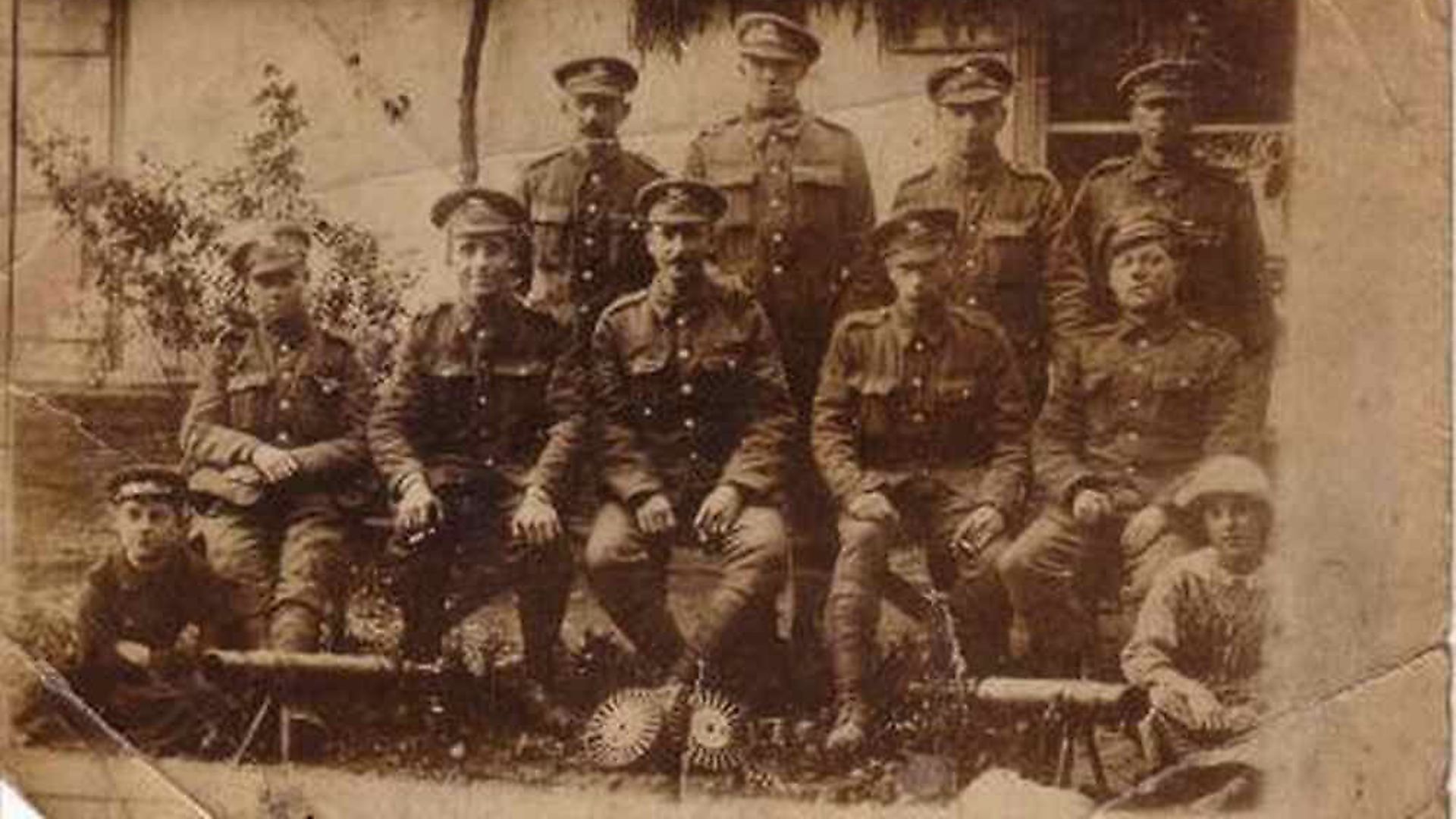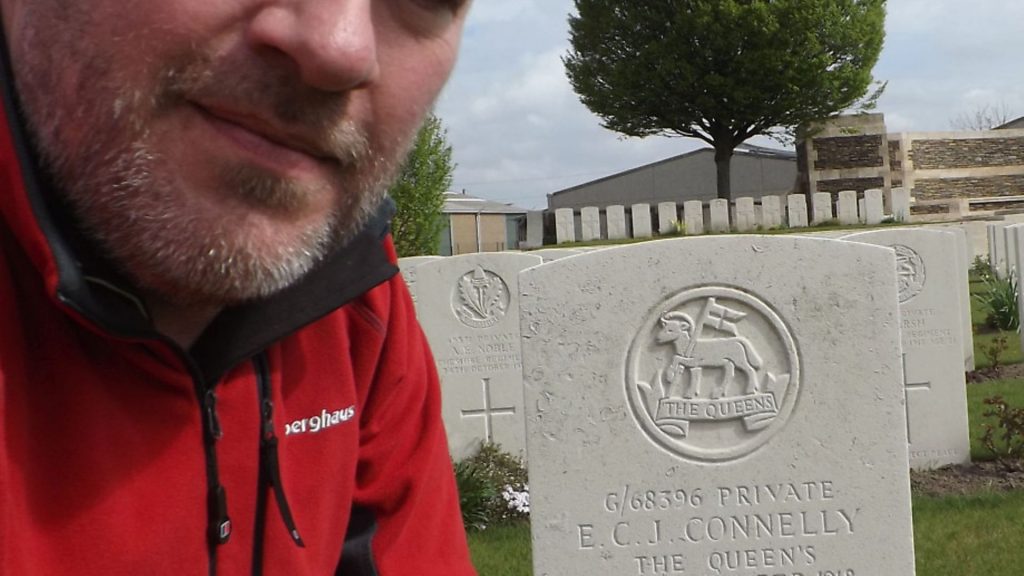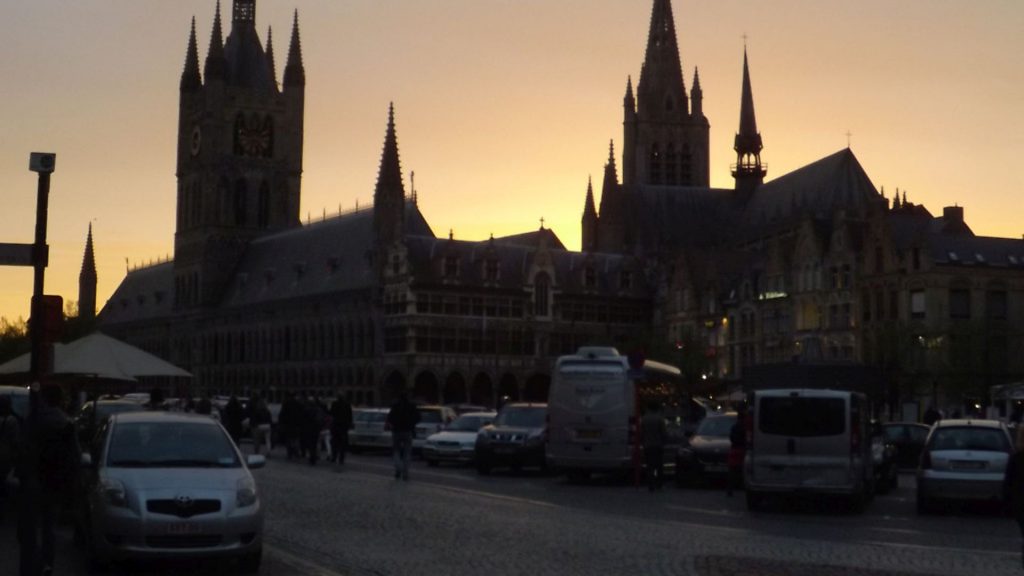
After his death in the final week of the First World War Edward Connelly faded from family history, until a chance discovery by CHARLIE CONNELLY. He started to piece together the details of his relative’s short life and, in a powerful act of remembrance, undertook a personal pilgrimage, from the soldier’s place of birth to his final resting place.

It was one of those inherently damp wintry days on which the cold somehow seems to start inside your bones and work its way outwards. My hand was as cold as the stone on which it rested lightly in front of me. They came one by one, approaching where I stood, stooping to add a single flower to the growing pile in front of the stone, straightening, bowing their heads and walking on. The young, the elderly and the in between, faces pink with cold, none of them making a sound.
An imposing man in military uniform, a dozen medals pinned to the breast of his Belgian army greatcoat and gold braid around the rim of his officer’s cap denoting a man of high rank, approached the stone, bent a knee to lay his flower, straightened, pushed his shoulders back, gave an impeccable salute, dropped his arm to his side, inclined his head for a moment and walked on. The stone behind which I stood was exactly like the thousand or so others around it in the Harelbeke New British Cemetery, around 20 miles east of Ypres. It’s exactly like the many thousands across Europe in cemeteries as large as the vast Tyne Cot, where nearly 12,000 lie, to tiny plots of a few dozen in the corner of a farmer’s field.
It’s exactly like the thousands more in Commonwealth War Grave Commission cemeteries right across the world, impeccably white in their Portland stone against the vivid green of carefully tended grass, all exactly the same size and shape, all with names and dates carved in letters of the same height regardless of rank, race or creed because everyone is equal under the earth.
The stone behind which I stood commemorates Private Edward Charles John Connelly of the 10th Battalion, Queen’s (West Surrey) Regiment, who was killed 100 years ago this week, on November 4 1918, a week before the Armistice. He was 19 years old and he was my great-uncle.

I’d been invited to Harelbeke as a guest of honour at their annual Armistice Day remembrance service. A few minutes before that poignant procession past Edward Connelly’s grave I’d been honoured to read aloud the familiar lines from Laurence Binyon’s poem For The Fallen about them not growing old, about how age shall not weary them and how at the going down of the sun we will remember them, and then a bugler had sounded the eloquent cadences of The Last Post, the familiar notes rising into the chill Flanders air over the distant whisper of traffic.
This was my second visit to the cemetery. I’d made my first journey to Harelbeke a few months earlier and I’d made it entirely on foot. I owed great-uncle Edward that much.
I’d stumbled across Edward Connelly while dabbling in some family tree research. I knew my grandfather, 16 when the war ended, had joined up after lying about his age because my father had told me, adding that he’d never talked about it. But I couldn’t recall ever hearing about his elder brother, killed just seven days before the Armistice, the same day as Wilfred Owen.
I phoned my dad and mentioned that I’d come across his uncle who’d died in the final half-hearted skirmishes of a war all but won. There was a long silence at the other end of the line, one that would expand into the silence of a century. ‘I never knew about that,’ he said.
My dad didn’t know he’d even had an uncle Edward, his own father’s brother. His father had never mentioned him, not once, not ever. It might have been too closely associated with his own trauma, memories and experiences he’d suppressed. Maybe he’d joined the same regiment, maybe he’d even been there when his brother was killed, maybe he’d seen him fall but had to keep going and not turn back. For whatever reason Edward Connelly had vanished entirely from the family history, but for one small exception: my grandfather had given my dad the middle name Edward.
The more research I did the clearer it became that as well as vanishing from the family narrative Edward Connelly had left next to nothing behind. I obtained his birth certificate confirming he’d been born in April 1899 at Gadsden Mews in the heart of the slums of North Kensington in west London. He appears on the censuses of 1901 and 1911 – the latter revealing that he was deaf in one ear – and I found an employment record that showed he worked washing the soot and filth from railway carriages at a local marshalling yard. Other than a scatter of cursory references in military archives to his death, that was it.
I made two small breakthroughs. First a distant relative in Australia got in touch with a scan of a photograph passed down to her that showed a small group of soldiers from the First World War. ‘I believe one of them is him’, she said. It’s a slightly blurry picture but by process of elimination I decided he was the lad seated on a chair at the far left of the group, his uniform too big for him, trying to set himself the way a man much older would. He’s trying hard to look like a soldier but he just looks like a boy.
I tracked down a copy of his will. Edward was 18 years old when he wrote it, something required of all soldiers of the Great War. It was dated April 2, 1918, and written on a single sheet designed for the purpose. He probably wrote it at a training camp somewhere in England, on his bunk with his new colleagues, some frowning and chewing their pencils, others wisecracking about which of their sweethearts should get something, trying to make light of the fact they were not even out of their teens yet and they were writing their wills. As he wrote his Edward had seven months to live.
‘In the event of my death,’ it reads in a clear but slightly shaky script, ‘I leave my War Savings Certificates to my goddaughter, Miss Lily S. Hill of Spencer Street, Southall, and £2 to my grandmother Mrs Christopher, No. 5 Branstone Street, N Kensington, the remainder of my money and effects going to my mother Mrs G. Connelly, No 6 Branstone Street, N Kensington.’
When Edward joined the British Army they were desperate for numbers. The Germans had made great inroads into France with the all-or-nothing push known as the Spring Offensive and the Allies had suffered heavy casualties that needed urgently replacing. Until then British 19-year-olds could enlist but weren’t sent out to fight, a regulation that was relaxed in 1918 at the same time the upper age limit for enlistment was raised from 41 to 50. The deafness mentioned on the 1911 census would ordinarily have excluded Edward from military service but by the spring of 1918 any boy would do, even a deaf one.
When Edward was shipped over to the Western Front he knew how to fire a gun and use a bayonet, he knew his gas drill, how to dig a trench and had done a lot of marching. He had a uniform, a mess tin, a cigarette ration, had even a made a will, but he wasn’t really a soldier. He wasn’t even really an adult yet, just a kid in a uniform, a number, part of a quota on a sheet of paper rubber-stamped somewhere a long way from the mud, rats, lice and blood of the Western Front.
His life might have been brief, he might have left next to no mark on the world, but he mattered. The reasons why he was forgotten are awful and understandable but having unearthed the scant bureaucracy of his life I needed to draw Edward out from the wispy caverns of history. Something had to be done, some amends made. I looked at his birth certificate, I looked at his burial record and I decided that as a kind of penance I would walk from his birthplace to his grave.
That’s why I found myself one gusty morning standing in the middle of a west London municipal basketball court between two tower blocks off the Harrow Road. Gadsden Mews was long gone now but scrutiny of old maps told me that I was in the right place, where Edward was born. Looking a little incongruous with a rucksack on my back and sturdy boots on my feet, I adjusted my pack, exhaled and set off for Flanders.
I passed through London, picked up Watling Street and crossed the undulating South Downs to Folkestone, from where it’s most likely Edward would have embarked for France after his training. No ferries cross from Folkestone these days so I made my way over the chalk cliffs to Dover where early one warm and hazy morning I crossed a silk-smooth English Channel to Calais. When Edward made his journey, crammed on a troop ship, the roughness of his tunic collar rubbing against his neck and nagging at him like the cold fear in his stomach, he had no idea that he’d seen England and everything and everyone he’d ever known for the last time.
Having made my way along the French coast and crossed the Belgian border I turned inland and made for Poperinge. The English leg of my journey had been a pleasant ramble through rolling countryside but now I was following the route that Edward and thousands like him would have taken to the Western Front and it wasn’t just the spirit level-flat landscape of Flanders that was different.
I began to pass with increasing regularity Commonwealth war cemeteries in locations innocuous and incongruous (one small one was in a farmer’s ploughed field, for example, its white stones and manicured turf enclosed by a low wall in a sea of churned mud), and saw the small piles of rusted metal at the corner of fields, war detritus ploughed up every year by Flanders farmers.
Poperinge, around 10 miles west of Ypres, was far enough behind the lines that periods of leave could be passed there, raucous evenings spent in the bars and éstaminets, days spent in the main square perusing stalls selling souvenirs and black market goods, smoking, chatting, doing normal things. It’s also home to Talbot House, a remarkable establishment set up in a vacant chateau by the Reverend ‘Tubby’ Clayton, where men of all ranks could drink tea, read newspapers, watch a show put on by troops or attend services in the attic chapel whose makeshift altar was fashioned from a carpenter’s sawhorse. It remains open to visitors, retaining a calming stillness throughout the house and its garden; tea still served in the conservatory in china cups.
A few days before I reached Ypres two construction workers were killed at a building site on the outskirts of the town when an old shell was disturbed and exploded. For us the war is something that happened in another place, for the people of Flanders in particular it remains very much in the present. Tragedies like this aside, the town itself is one big reminder of what happened here. Ypres was completely flattened during the First World War but its centre was painstakingly reconstructed brick by brick, most notably the cathedral-like 12th century Cloth Hall that dominates the main square and now houses an excellent museum. I walked in its shadow to the nightly commemoration at the Menin Gate through which thousands of soldiers, including my great-uncle, passed on their way to the front.
The current triumphal arch dates from 1927 and is inscribed with the names of 54,395 Commonwealth soldiers killed but whose remains were never recovered or identified. Traffic through the gate stops every evening for a rendition of The Last Post by buglers from the local fire brigade, and as the plaintive notes sounded the ceremony was bathed in the golden light of a vivid sunset that cast long shadows across the cobbles.
I passed through the Menin Gate the following morning, sun shining, flowers blooming in the tidy gardens of suburban homes, as unlike the same vista a century earlier as it’s possible to imagine. In 1918 Edward would have trudged through the gate into a blasted landscape of shell craters and old trenches filled with brown water, mud-caked, lice-infested soldiers squelching their way east over saturated duckboards between indistinct lumps of twisted metal and the occasional corpse; a boot sticking up from the mud here, a hand emerging from a swampy brown pool there.
By contrast my route from Ypres to Harelbeke along the Ypres-Comines canal and River Lys was peaceful and blessed with warm weather all the way to Kortrijk, where I’d spend the last night of my journey. It had taken me a little under two weeks to walk this far, retracing and acknowledging a life of 19 years cut short in the cruellest and most needless of manners: Edward Connelly was the only member of his battalion killed in the last three weeks of the war. The Germans had thrown everything into their Spring Offensive but with resources scarce there was nothing propping up the advance and the final weeks before the Armistice saw the British chasing them back towards the German border.
According to Fhilip Vannieuwenhuyze, a local historian with whom I’d been in contact, Edward was probably killed crossing a field outside the village of Kerkhove – possibly by a retreating machine gun unit chancing their arm – and buried originally where he fell before being exhumed and transferred to Harelbeke. Later Fhilip would walk me through Edward’s last hours, pointing out bullet holes in old farm buildings that might even have been made over his head as he passed, until we dashed across a busy dual carriageway and found ourselves looking across an unremarkable field lined with unremarkable trees, an unremarkable place to die in an unremarkable skirmish.
It’s about an hour’s walk from Kortrijk to Harelbeke, whose cemetery lies to the north of the town next to a small office block and opposite a drinks wholesalers. I approached from the west and saw first the Cross of Sacrifice that features in all but the smallest Commonwealth War Grave Commission cemeteries. I left my pack by the entrance, felt the relief of its weight lifting from my shoulders and made my way along the centre aisle until I was about three-quarters of the way back.
I turned left, moved along the line of headstones and there it was, simple, white and indistinguishable from the rest. Beneath the insignia of the Queen’s Regiment the inscription read, ‘G/68396 Private E.C.J. Connelly, The Queen’s, 4th November 1918’. I was his first visitor and it had taken nearly a century.
Edward Connelly was an unexceptional soldier. He wasn’t at the Somme, Verdun or Passchendaele and was awarded posthumously the standard campaign medals given to every combatant. There were no bravery citations or mentions in dispatches. Although he was the only member of his battalion to die in the war’s final weeks he wasn’t even named in the official diary kept by the commanding officer, just ‘1 O.R.’, one of the ‘other ranks’, not an officer, not worthy of a name.
He even disappeared from his own family narrative and it wasn’t until that procession of people at the Armistice service that I felt Edward’s memory had been in some way restored. There are thousands upon thousands like him in cemeteries across the world, in my family history and in yours, some visited, some commemorated, others forgotten.
He was a half-deaf teenager from the slums of west London who made his living scrubbing railway carriages. He left his War Savings Certificates to his goddaughter and £2 to his grandmother. He was killed exactly 100 years ago, on November 4, 1918. His name was Edward Charles John Connelly and he was 19 years old. He is remembered.
The Forgotten Soldier by Charlie Connelly is published by Harper Collins, price £7.99










